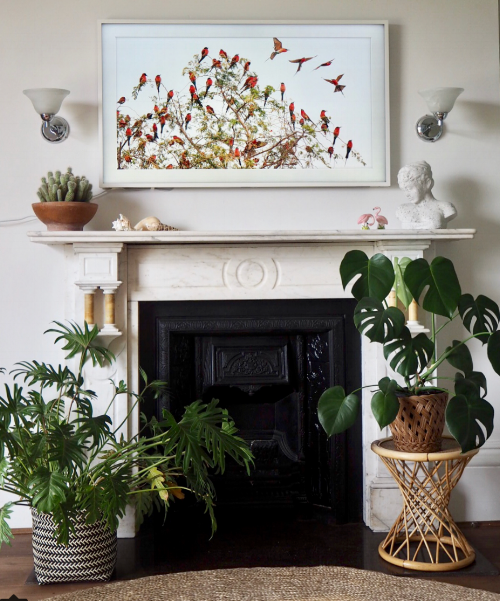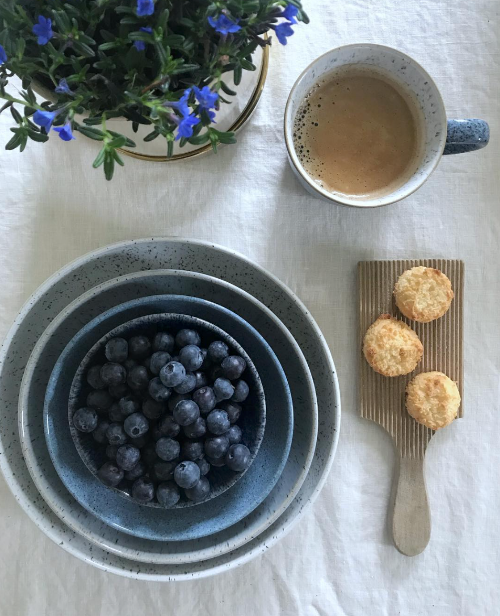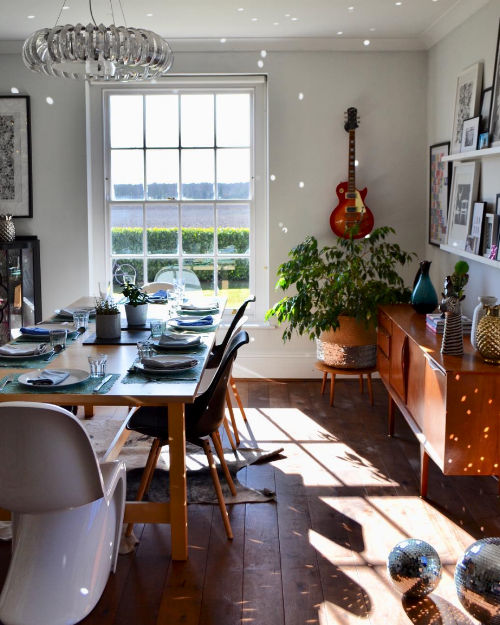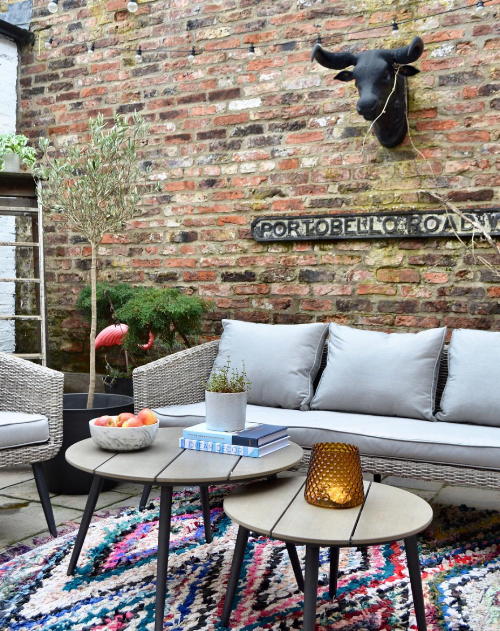Everything You Wanted To Know About Being A Social Influencer But Were Afraid To Ask
Two and a half years ago, I started posting very poor and shockingly styled photographs of my home on my Instagram account. I'd had the account for a while, posting pictures of my feet on floors, glasses of wine and filtered as fuck sunsets. After moving from the South to the North and buying a renovated Georgian manor, I documented what I was doing on my feed and before I knew it, my following started climbing up and after ten months, I'd reached 20,000 followers, a ridiculous figure that I would never have imagined was possible when my only real motive previously was to stalk my kids. The interior community on Instagram was much smaller at this point; there were fewer UK interior hashtags and we were very much led by the USA in terms of how and what to post. I launched a blog, writing weekly about how to style your home on a budget and ran it in conjunction with my Instagram account. All good.
The sort of quality shot that appeared on my Instagram account pre January 2016.
Fashion and beauty already had a stronghold on this social media platform. Accounts that had been around for years, established and respected with huge followings and a huge, influential impact on their demographic. There wasn't really anything comparable on the interior side. The launch and use of hashtags such as #myhomevibe created specific feeds that were interior led and a community evolved from this that enabled small brands to promote their products.
When I first started posting, the idea of promoting business via my feed hadn't even crossed my mind. I had no idea what I was doing - my first posts were so badly photographed that they could have been shot by my nine year old. As someone who had always had an eclectic mix (AKA lots of shit) in my home, seeing other people's ideas was super inspiring and I soon started buying accessories and interior bits via the small businesses that were starting to appear on my feed. Many of these shops were home run, virtual businesses without bricks and mortar locations. I'd post the items that I'd purchased and would tag the shop that they came from. It was a super friendly and engaged community - other accounts would see the new products, ask where they were from and then go and follow the shop and make a purchase.
By May 2016 I had reached around 5,000 followers and a small business to whom I had chatted online messaged me to ask if I would like to receive some gold mugs for my kitchen. I jumped at the chance, she sent them to me, I styled them nicely in a shelfie shot in my kitchen. I tagged the brand, told my following how much I loved the mugs (which I did) and linked the shop in the comments. By doing this, together we expanded her market place to my 5,000 followers, she gained traffic to her site and new followers to her Instagram feed. The following week, another small shop sent me a print I loved as a gift which I framed, styled and posted. Again, traffic was driven to their feed and they gained a significant amount of followers and sales. Everyone was winning.
Such superb styling, I'm surprised I wasn't immediately pronounced the UK's answer to Emily Henderson. The Gingham filter really gives it the edge.
Two years on and things have zoomed ahead. Usage of Instagram has grown during this period from 400m to 800m monthly users. Seriously. More users than Twitter, the introduction of Instagram Stories has overtaken Snapchat with well over 200m daily users. Along with many others, I now work full time on social media - I write a weekly blog and have over 100k followers on my Instagram account. I collaborate with brands and work with them to produce content for their social channels and mine, both on my own website and my Instagram feed. Most of this is paid and it's allowed me to be able to give up my previous extremely boring job as a freelance transcriptionist and concentrate entirely on my new career.
But what is my job? What do I even call myself? I literally cannot tell you how many times I am asked this question. If you don't use social media, you won't have the faintest idea what I do. Although to be fair, even Buddy my dog has his own Instagram account so the chances that you don't use any sort of social platform is pretty small. Recently, there's been a lot of talk - on many platforms - about the concept of 'influencing' and whether or not it's fair on the people that follow feeds that are classed within this category. Is it possible to remain authentic when you are using your account to promote a branded product? My niche is interiors, so I'm going to tell you what I do and how it works. Full disclosure. And in the third person, mostly because it's more fun that way.
Right. Let's start with a job title.
So I write. A lot. I write a blog, I write content. I run workshops. I also product photographic content for myself and for brands. I influence, because if people see it on my feed in my home, they are more likely to buy it. But tbh, I'm not overly keen on that word. It sounds a bit wanky. So if asked what I do, I say I'm an Interior Writer and Content Creator because that's what I do the most. That possibly also sounds a bit wanky. But hey, it's a new sector, I can call myself what I want.
And an average day?
One of my first collaborations and one that made my husband VERY happy.
I receive e mail. Lots of it. E mails from brands asking if I will work for them. E mails about workshops. E mails from small businesses. E mails from magazines asking me to contribute. Oh, and e mails from people asking me if they can guest blog on my website. Bloody loads of them. And a ridiculous amount of spam e mails that I thought would be removed after GDPR but still appear to be there. I spend the majority of my time writing content for both my own blog, my Instagram feed and brands, negotiating work and styling shots. I have six hours from when I drop my son at school to when I pick him up and I spend virtually every hour of that at my desk. When I'm not at my desk, I'm on my phone. I receive approximately 300 direct messages per day (mostly in response to my Instagram Stories) and I reply to every single one. I look at my phone at least every fifteen minutes throughout the day to keep on top of this.
In the evening, I'll post on my Instagram feed at approximately 7.30 pm. I then respond to every comment for the first hour, almost immediately. I'll have a break and then when I go to bed, I catch up with the comments. In the morning, I respond to the comments and direct messages that have come in overnight. Then it all starts again.
I don't spend nearly enough time tidying my house or doing the washing but I do drink a lot of coffee and eat a lot of Finn Crisp and vegan cream cheese. Oh, and I go to London for the day for brand meetings and events once every two weeks. Once a month (or more) I travel to other parts of the country to run workshops with my friend, Dee Campling. That's about it.
You spend A LOT of time on Instagram. Why bother spending all that time responding and replying?
There's two parts to this. Firstly, my following is completely 100% organically grown. If someone has taken the time to comment on my post or send me a message, then I feel that I should respond. Always. It's rude not to and it's basic politeness. Also, I really like talking to my followers and receive messages from the most interesting, amazing, varied demographic of people that it's possible to receive from. People from all over the world, from every sector, a huge knowledge base. I've learnt more being on Instagram over the last two years than I've learned in the previous forty.
Secondly, I earn money by working with brands. When I engage, Instagram pushes me forward in the rankings and my impressions and reach go up. This makes me more valuable to brands. Brands want to see that I have an engaged account, otherwise they won't want to employ me. Most of the time, before they employ me, they will ask me for proof of demographic and statistics. They're putting trust in me to do a job, so they need to make sure my account is authentic, organic and that I haven't bought my followers.
Tutorial collaboration with a High Street brand.
So this whole brand thing. Isn't it all about freebies?
ARRGHH. Let's get this clear right from the start. There's no such thing as a freebie. I mean, seriously. This is the real world, nobody gets anything for nothing. Everybody knows that, yet it still doesn't stop the word being bandied about. It's a business transaction, pure and simple.
Two years ago, I received a lot of cushions as gifts from small businesses and independents. Don't get me wrong, I love cushions. Although every cushion that arrived into the house would almost send Joe over the edge. To say thank you - although this was in no way a condition of them sending the cushion - I included their item in a room shot if I felt it suited my aesthetic and my home and I really liked it. My feed is almost purely room shots of my home. When I posted a picture, I would tag the brands featured in it, including the brands that I had purchased items from. This worked for the small business as it enabled them to get their product out into a public forum in an organic way.
Fast forward to today and the same applies. I work for a brand, they send me the product, I style the product in my home. I promote the product on my social feeds, whether that be my blog, my Instagram or my Facebook page. The only difference is that now I get paid for doing so. It's my job.
But why should you get paid? Surely you're just happy to receive a free product?
No. I'm not happy to just receive a free product. I need to be paid for several reasons.
1. This is my full time job. I spend a significant amount of time creating content and producing photography for projects and campaigns. This content has to be acceptable to the brand and also be appropriate to my feed. It's a lot of work - it's not uncommon for brands to make changes after I've submitted the project - and takes time to get right. Would you go to work for no pay? Nope. Why should I?
2. I have 108k followers and many blog readers. This is a wider audience than many magazine circulations. It costs a lot of money to put an advert in a magazine. Why should brands pay magazines for advertorial and not me? Prior to the advent of social media advertorial, magazines and brands spent a significant amount of money on photo shoots and campaigns. Such shoots required many people on site, each being paid individually for their time. I'm a photographer, a stylist, a project manager, an assistant - all in one.
3. I need to pay the mortgage, I need to pay bills, I need to pay for my son's endless football clubs and my daughters endless clothes supply. I need to contribute to our family income. I can't do that by working full time on social media and not earning any money.
Tableware collaboration with a British pottery brand.
What about the small independent businesses? Do you charge them too?
I still have lots of contact with small independent businesses - these companies are the foundation of my account. There's no fee attached to these relationships and as long as the gift fits with my home, I am generally happy to Story their product and even do a swipe up link to their website (although again, this is not a condition of them sending me a gift - I choose to do this myself). It's organic and authentic as I would only accept a gift if I truly loved the product, plus it gives them a platform to reach an audience that they wouldn't otherwise have access to.
But don't your followers feel as though they're constantly being sold to?
I am very careful about planning my feed and content. I don't do lots of advertorial in one go, I space it evenly. I write regular sponsored blogs but I always ensure that my Sunday blog is my own personal content and views. If I didn't earn money from working on content, then I wouldn't be able to spend time posting, blogging and engaging with my followers. I wouldn't be able to maintain my account.
I spend huge amounts of time and thought creating sponsored content that gels and fits with my feed, sponsored content that my following will like even though they know that I'm working in collaboration with a brand. My demographic also know that I wouldn't promote any item that I don't actually have in my own home - this is something I refuse to do as it smacks of non authenticity. If it's not in my home, it's not going on my feed.
But what about if you are asked to work with a product that you don't like?
I would never work with a product or brand - paid or otherwise - that I wouldn't have in my own home. Ever. I just wouldn't. It doesn't fit with my authentic ethos. I regularly turn down proposals of work if I don't feel that the product fits my feed or audience. If I'm approached by a brand or small independent business and I don't feel that their product is appropriate for my home, I will refer them to another blogger or Instagram account that I think would gel instead.
Seasonal food campaign collaboration with a High Street brand.
So how do you declare advertorial or gifting on your social platforms?
If you are promoting a brand or being paid by a brand on social media, you are bound by ASA (Advertising Standards Authority) regulations. So if you see me tagging either of these words, you will know that I'm working.
#ad - This tag signifies that the brand has influenced the content produced in some way. So, if I work for a company to produce an Instagram post and an accompanying blog and they have asked to view my content prior to posting, then I would use this tag. This is usually paid content.
#spon - This means that the content is there because I was either paid to produce it or received gifts in lieu of payment to produce it. So if I work with a brand and they do not ask to approve it prior to posting (ie, it's my own content), then I would use this tag. Or if they have specifically asked me to produce a piece of social media content in return for a product instead of a fee. It signifies that what you are seeing is my own ideas, creativity and content using the product supplied by the brand.
With regard to gifted items - ie, if a small brand messages me and asks if they can send me a gift - I make it abundantly clear on my Instagram Stories that I have been sent this as a present. There is no obligation for me to post content or promote the items - this is entirely my decision.
Instagram are currently rolling out the partnership option which will make life much easier and also make everyone aware that you have been paid to post. This will sit under your name and above the content photography.
What about social influencers who don't declare that they are posting advertorial?
Any good influencer who takes their position seriously and is treating their account as a business will be following ASA guidelines to the letter. There's absolutely no benefit to not declaring advertorial. And that's really all there is to be said on the subject. It's a free country - you can decide whether or not you care about their lack of declaration or not. If you don't, keep following them and enjoy what they post. If you do, let your fingers do the talking and UNFOLLOW them. It's simple. Where's the argument?
Let's go back to everyone's favourite word. Freebies. The ongoing hot topic of some social forums. Here's an example - if you were offered a fully paid, family holiday in the sun in return for producing content, would you take it?
Outdoor collaboration with a European homewares brand.
Yes. Anyone in my position who says that they wouldn't is lying. Just to clarify, I'm not jetting off to Mauritius with an empty purse any time soon. However, I write about interior lifestyle and I know my audience. I know my demographic, I know that they love what I love, that's why they follow me. I like going on holiday - I even have a palm tree tattoo to confirm this. I know that my following also like going on holiday. So that's a match.
If I was asked to race cars in Le Mans or go and see The Ashes in Australia, I would say no. If I was asked to go to a fitness retreat which involved me having to run for miles every day, I would say no. I'm not interested in cars or cricket and I don't like running. I've got to the age of 47 without ever having to do it and I've no intention of starting now. Non authentic. My demographic would KNOW.
A free holiday, though. Surely that's not work?
Whether I am sitting at my desk in York or lying next to a pool in Mallorca on a holiday paid for by myself, being served a mojito and olives by a good looking Spanish waiter, I am working. In order to carry on doing my job, I need to maintain my account by regularly and consistently posting. Posting on my feed, posting regularly on my Stories. I have never allowed my Story feed to drop since it was first introduced in 2016.
If I don't post, my engagement and reach will drop and I won't be able to show brands that I have a strong demographic. If I can't do this, I don't have a job. Social media never stops, it's a 24 hour a day gig - I work directly with brands and agencies most weekends (the busiest time of the week), my e mail pings at midnight if I'm working with a brand who is not in this country.
I'm not complaining - I chose this as a career - but I am fully aware that I am employed solely based on my statistics. A lot of the content I produce is approved prior to posting - this involves huge amounts of admin, going back and forth, redoing if the client isn't happy. If I was asked to do a campaign based on a family holiday, this would still apply. It's a job. It doesn't matter where in the world I am. So tying in my job with being able to spend time with my family and introducing them to new experiences? Anyone who would turn that down would be NUTS.
The idea of using social media as an influencing tool has recently been the focus of many a forum and conversation on various social platforms. It's a subject that raises questions, mostly because it's new and therefore has no boundaries. Whatever your views on this new career path - and career path it is - it's not going anywhere. It's not a fad, it's not temporary. For brands, it's an organic way of reaching their demographic by focusing on the reach of the accounts that best suit their product. For followers, it's a way of discovering new brands and products, new independent businesses, through accounts that they follow and enjoy. Done correctly, a good collaboration campaign between brand and influencer is like a page in a magazine that's entirely tailored to your style.
Oh, and a final thing. Instagram is a creative, friendly, inspiring social media. It's encouraged women and men - no matter what their interests - to be creative, to network, to try new things, to start new business, to do things that they've always wanted to do but never had the platform on which to build. It's a positive and progressive environment and these new job roles and ideas that evolve from it are what keeps it interesting. So let's keep building it up and not knock it - and the people who work within it - down.







